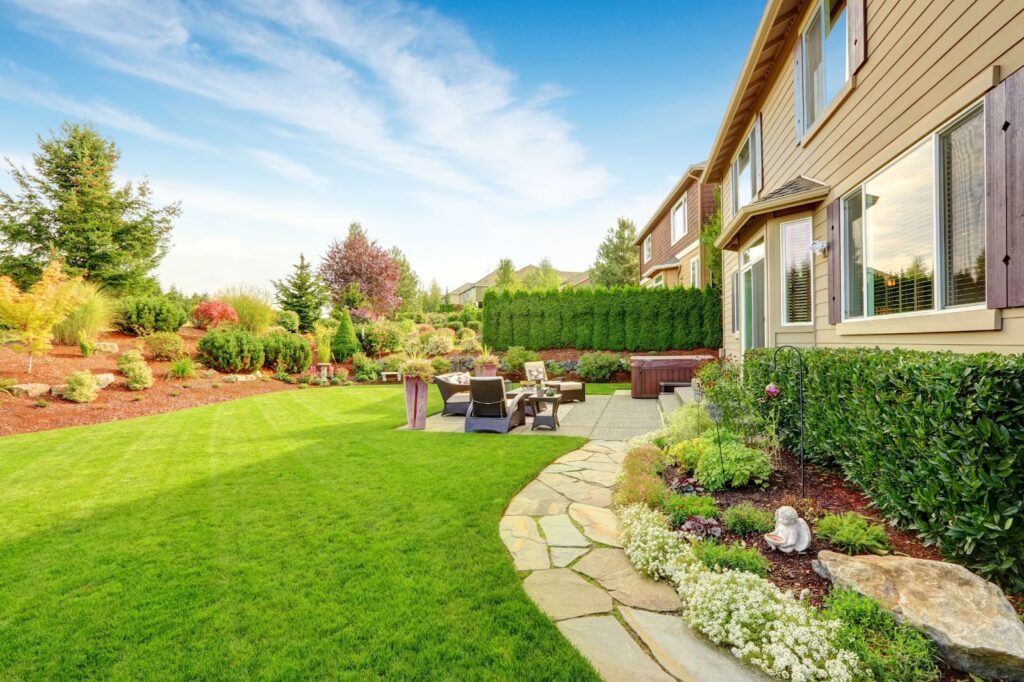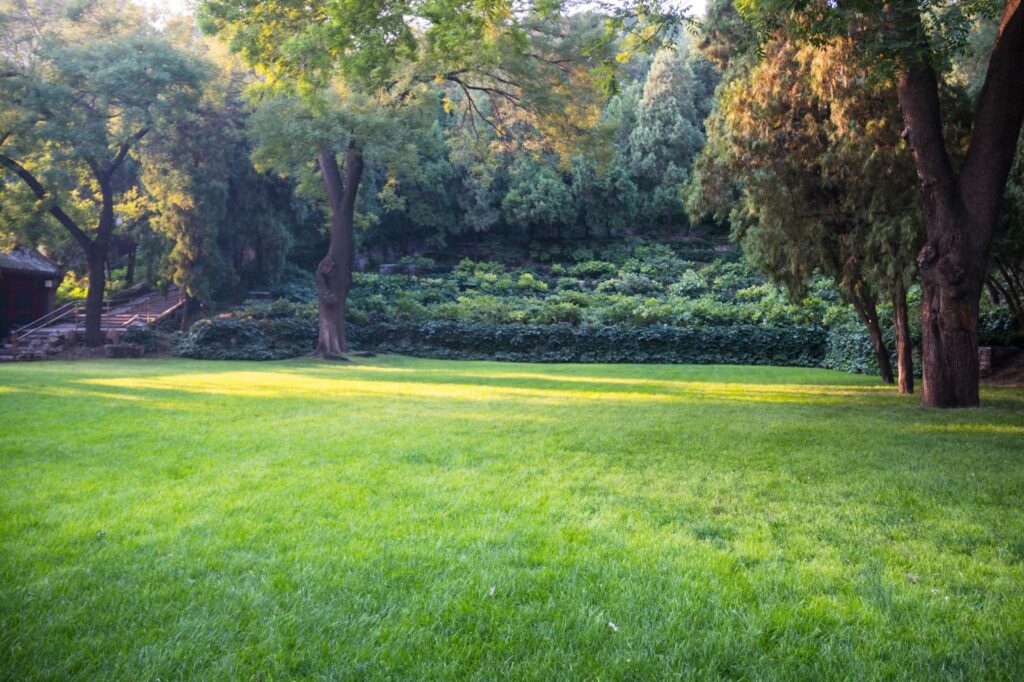If you want to improve your backyard water drainage, check out these yard drainage specialist-approved tips.
A well-designed yard drainage system is essential during heavy rain and snowfall. Good drainage does not need to be difficult or expensive. Some projects can even be done yourself.
If you have noticed stagnant water pooling outside, soggy patches of grass, puddles in your basement or on exterior basement stairs, or slower drains due to potential clogs, it may be time to reevaluate or explore water drainage solutions.
A proper system should drain flooded areas of your lawn and prevent water from flowing towards the home’s foundation, keeping your house safe and in good condition.
Continue reading to learn more about backyard water drainage systems and how to keep your yard dry before the snow falls.
13 water drain solutions for your backyard
Reassess your backyard grading
One of the quickest fixes for a soggy lawn is to add dirt and slope it away from your home’s foundation. According to our yard drainage specialist, this should always be a homeowner’s first consideration when dealing with poor drainage.
Sloping the grade isn’t as simple as throwing down some dirt and raking it smooth. Make sure there’s a minimum of four inches between the slope and the bottom of your home’s exterior (siding, brick, etc.).
Bagged mulch and topsoil are not ideal for grading soil because they’re permeable and could wash away. Instead, opt for a harder, clay-like soil that packs tightly and helps hold the slope shape you sculpt.

Replace hardscaped areas with drainage materials
Hardscape areas in your backyard are great for driveways and patios; however, asphalt, concrete, and other hardscaped materials sometimes divert water in unwanted directions.
If any asphalt or concrete slabs are sloped toward the house, water could cascade to your home’s foundation. If you can, replace hardscaped materials with pea or crushed gravel to encourage drainage. If you don’t want to give up your hardscaping, consider sloping with more concrete or asphalt to ensure water steers away from your home.
Add a channel drain
As previously mentioned, concrete and asphalt walkways and driveways could send water in the wrong direction. In these instances, it’s necessary to stop the water in its tracks with a channel drain.
This project requires a narrow trench cut into your hardscape material. Next, install a long channel drain in the trench. When water hits the drain, it is diverted in another direction away from your home structures.
Install a French drain
Water moving across your yard may be challenging to control, especially when it comes from outside your home. Thankfully, French drains are a low-cost option for managing this water.
French drains feature trenches filled with a permeable material, such as gravel, over a perforated PVC pipe. Water easily travels through the gravel and into the PVC pipe, which swiftly moves water away.
Aerate your lawn
Aeration will help the grass stay in its best condition. Aeration creates small holes in the first few inches of the grass to introduce nutrients and oxygen and helps break up compacted soil beneath.
In addition to your yard’s health, aerating also promotes yard drainage. Instead of pooling on the surface of your grass, the water gathers in the hundreds of holes on its surface.
Loosen compacted soil
Similar to aeration, you can loosen compacted soil in other ways to encourage better drainage in a smaller yard. Use a spade, pitchfork, hoe, or tiller to overturn clumps of soil. For a larger yard, you may want to expedite this process with motorized tools.
Loosen dense soils by introducing other materials, such as organic matter or pea gravel.
Create a dry creek bed
Dry creek beds give you the best of both worlds: a beautiful and functional landscape. A dry creek bed is built from various rock types and serves as a planned channel for stormwater. Rather than letting nature pick its course, you can pick its course from the downspout to the edge of your property.
When diverting water isn’t working, dry creek beds are a beautiful form of xeriscaping for your lawn.
Install a rain barrel at the end of your downspouts
Put water from your downspouts to good use while avoiding drainage issues. Build or buy a rain barrel and place it where it will catch the water from your gutter system’s downspout.
By reconfiguring this, you can collect water and recycle it for later use in your gardens. This is one of the easiest and most affordable water drain solutions. Some states regulate rainwater collection and its use, so check your local regulations before investing in this solution.
Add extensions to downspouts
Downspouts carry water from the gutters along your roofline down to the ground, pushing it away from your foundation. Moving water away from your house is essential; in some cases, adding an extension is the easiest, fastest, and least expensive way to do so.
Without an extension, water could gather in your front or back yard, causing drainage issues. Clamp one of these flexible plastic tubes to the end of your downspout to move water another four feet from the foundation of your home.
Clean your gutters and downspouts
Important water drainage solutions should not be overlooked. Good backyard water drainage starts with your gutter system. First, your gutters should be the right size for your property, leading to downspouts. Second, make sure you clean your gutters twice a year.
Cleaning gutters is a relatively simple weekend project if you have a ladder, a blower, a gutter rake, and a bucket. If you would prefer, hire a professional cleaning service to tackle the project instead.
Plant a rain garden
A rain garden is a landscape component located where water tends to puddle. This element captures and diverts water into the ground. Plants native to the area with deep roots help retain water in the space rather than flooding the rest of the yard. The location needs to be precise to avoid creating additional drainage issues.
Make a yard drain
A yard drain is built directly into the ground in areas where flooding has previously been a problem. Acting much like a bathtub or shower drain, yard drains are passive channels for water that flows through them. A yard drain will divert water through hidden pipes to a termination spot, such as a dry well.
Build a dry well
A dry well is a large basin filled with rocks installed underground. It serves as a collection point for water and works in conjunction with other yard drainage methods. A dry well can absorb large amounts of water and percolate it into the surrounding soil.

Contact LaytonScape to solve your backyard water drainage problems
Sometimes, the best option is to call in a yard drainage specialist to manage a soggy lawn, and the pros at LaytonScape can help.
There’s nothing worse for yards than a persistent water drainage issue. But our knowledgeable team is on your side to ensure the problem doesn’t persist. We want you to start loving and using your property again, even after heavy snow or rain.
Call the LaytonScape yard drainage specialist team today for your water drainage solution ― we’ve been repairing landscape moisture issues in northern Utah for decades, and we’d love to handle yours, too.

